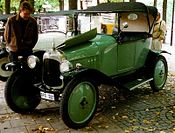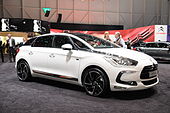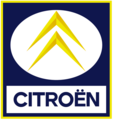Citroën
 Logo since 2022 | ||
| Company type | Subsidiary (S.A.)[1] | |
|---|---|---|
| Industry | Automotive | |
| Founded | 4 June 1919 | |
| Founder | André Citroën | |
| Fate | Merged with Peugeot to form PSA Group in 1976[2] | |
| Headquarters | , | |
Area served | Worldwide, except: | |
Key people | Carlos Tavares, CEO Stellantis Thierry Koskas, CEO Citroën (since 23 February 2023) | |
| Products | ||
| Services | Citroën Insurance | |
Number of employees | 13,900 Parent Stellantis | |
| Website | citroen | |
Citroën (French pronunciation: ⓘ[Note 1]) is a French automobile brand. The "Automobiles Citroën" manufacturing company was founded in 4 June 1919 by André Citroën. Citroën has been owned by Stellantis since 2021 and previously was part of the PSA Group after Peugeot acquired 89.95% share in 1976.[5] Citroën's head office is located in the Stellantis Poissy Plant in Saint-Ouen-sur-Seine since 2021 (previously in Rueil-Malmaison) and its offices studies and research in Vélizy-Villacoublay, Poissy (CEMR), Carrières-sous-Poissy and Sochaux-Montbéliard.
In 1934, the firm established its reputation for innovative technology with the
In 1954, they produced the world's first
History
Early years

The result was the
That same year, André Citroën briefly negotiated with General Motors a proposed sale of the Citroën company.[11] The deal nearly closed, but General Motors ultimately decided that its management and capital would be too overstretched by the takeover,[11] thus, Citroën remained independent until 1935.
Between 1921 and 1937, Citroën produced half-track vehicles for off-road and military uses, using the
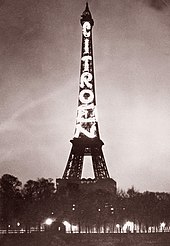
Citroën used the
Demonstrating extraordinary toughness, a 1923 Citroën that had already travelled 48,000 km (30,000 mi) was the first car to be driven around Australia. The car, a 1923 Citroën 5CV Type C Torpedo, was driven by Neville Westwood from Perth, Western Australia, on a round trip from August to December 1925. This vehicle is now fully restored and in the collection of the National Museum of Australia.[15]
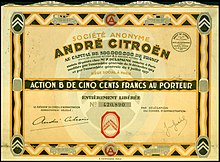
In 1924, Citroën began a business relationship with the American engineer Edward G. Budd. From 1899, Budd had worked to develop stainless steel bodies for railroad cars, for Pullman in particular. Budd went on to manufacture steel bodies for many automakers, Dodge being his first big auto client. At the Paris Motor Show in October 1924, Citroën introduced the Citroën B10, the first all-steel body in Europe.[16] These automobiles were initially successful in the marketplace, but soon competitors who were still using a wooden structure for their vehicles, introduced new body designs. Citroën, who did not redesign the bodies of his cars, still sold in large quantities nonetheless, the cars' low price being the main selling point, which factor however caused Citroën to experience heavy losses.[citation needed]
In 1927, the bank
Traction Avant and Michelin ownership
Traction Avant
The
Achieving quick development of the Traction Avant, tearing down and rebuilding the factory (in five months) and the extensive marketing efforts, were investments that resulted too costly for Citroën to do all at once, causing the financial ruin of the company. In December 1934, despite the assistance of the Michelin company, Citroën filed for bankruptcy. Within the month, Michelin, already the car manufacturer's largest creditor, became its principal shareholder.[17] However, the technologically advanced Traction Avant had met with market acceptance, and the basic philosophy of cutting-edge technology used as a differentiator, continued until the late 1990s. Pierre Michelin became the chairman of Citroën early in 1935. Pierre-Jules Boulanger, his deputy, became the vice-president and chief of the engineering and design departments. In 1935, the founder André Citroën died from stomach cancer.[18]
Research breakthroughs

During the
Citroën researchers, including
The 2CV
Citroën unveiled the
The DS
1955 saw the introduction of the
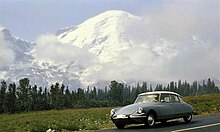
High pressure hydraulics
This high-pressure hydraulic system would form the basis of over 9 million Citroën cars, including the DS, SM, GS, CX, BX, XM, Xantia, C5, and C6. Self-levelling suspension is the principal user benefit: the car maintains a constant ride height above the road, regardless of passenger and cargo load and despite the very soft suspension. Hydropneumatic suspension is uniquely able to absorb road irregularities without disturbing the occupants[24] and is often compared to riding on a magic carpet for this reason.[25] These vehicles shared the distinguishing feature of rising to operating ride height when the engine was turned on, like a "mechanical camel" (per Car & Driver magazine). A lever ( later replaced by an electronic switch ) beside the driver's seat allowed the driver to adjust the height of the car; this height adjustability allows for the clearing of obstacles, fording shallow (slow-moving) streams and changing tyres.
Since Citroën was underfunded, its vehicles had the tendency to be underdeveloped at launch, with limited distribution and service networks outside France. Consequently, the early DS models experienced teething issues with the complex hydraulic system, eventually,[24] the hydraulic seals and system component design were sorted, becoming reliable.[26] Licensing such a technological leap forward was pursued to a limited extent: in 1965 the
Aerodynamic pioneer
Citroën was one of the early pioneers of the now-widespread trend of
Expansion and financial challenges
In the 1960s, Citroën undertook a series of financial and development decisions, aiming to build on its strength of the 1950s with the successful 2CV, Type H, and DS models. Nevertheless, these maneuvers were insufficiently effective, and Citroën went bankrupt again in 1974.
These measures were to address two key gaps facing the company:
- First, the lack of a mid-size car, between its own range of very small, cheap passenger vehicles ( 2CV/Ami ) and the large, expensive models ( DS/ID ).[28] In today's terms, this would be similar to a brand consisting only of the Tata Nano and Jaguar XJ. Because of its potential volume, the mid-size segment was the most profitable part of the car market and, in 1965, the Citroënesque Renault 16 stepped in to fill it.
- The second major issue was the lack of a powerful engine, suitable for export markets. The post-WW2 four-cylinder design.[31]
These steps include:
- 1963 – opened negotiations with Peugeot to cooperate in the purchase of raw materials and equipment, but talks broke off in 1965.
- 1964 – partnered with NSU Motorenwerke to develop the Wankel engine via the Comobil (later Comotor) subsidiary. For Citroën, this represented the chance for a technological run around the French Tax horsepower system by producing a more powerful but still small power plant. The first production car developed 106 hp from a 1-litre engine,[32] while the standard GS delivered 55 hp with a 1-litre engine.[33]
- 1965 – took over the French maker Panhard in the hope of using its expertise in mid-sized cars; cooperation between the two companies had begun twelve years earlier and they had agreed to a partial merger of their sales networks in 1953; Panhard ceased manufacturing in 1967.[28]
- 1965 – purchased the truck manufacturer Berliet.[28]
- 1968 – purchased the maker Maserati again with an eye to producing a more powerful car, keeping a small engine in line with the French tax horsepower system.[30] The first production vehicle developed 170 hp with a 2.7 litre engine,[34] this was the 1970 SM, which featured a V6 Maserati power plant, hydropneumatic suspension and a fully powered, self-centering steering system called DIRAVI; the SM was engineered as if it were replacing the DS family car, a level of investment that the small luxury Grand Touring carsector alone would never be able to support, even in the best of circumstances.
- 1968 – restructured worldwide operations under a new holding company, Citroën SA. Michelin, Citroën's longtime controlling shareholder, sold a 49% stake to Fiat in what was referred to as the PARDEVI agreement (Participation et Développement Industriels).[28]
The teams of Charles Marchetti and Citroën began working together on the development of the RE-2 helicopter.
From a model range perspective, the 1970s started well, supported by the successful launch of the long-awaited mid-size Citroën GS, finally filling the huge gap between the 2CV and the DS – with a 1-litre, hydropneumatically suspended car. The GS went on to sell 2.5 million units; 601,918 cars were produced in 1972 alone, up from the 526,443 of 1971, and enough to lift the company past Peugeot into second place among French auto makers when ranked by sales volume.[35] The older models continued to sell well: the peak production period of the DS was 1970, and 2CV was in 1974.
As the 1970s progressed, circumstances became more unfavourable. In 1973,
showed that there was a serious flaw with the plan particularly for companies producing engines with high fuel consumption.In 1974, the carmaker withdrew from North America due to U.S. design regulations that outlawed core features of Citroën cars (see Citroën SM).
Huge losses at Citroën were caused by the failure of the
The PSA Peugeot Citroën era
Fearing large job losses due to the poor cash flow situation and the unstable ownership structure, the French government arranged talks between Citroën and Michelin culminating in the merger of Automobiles Citroën and Automobiles Peugeot into a single company. Thus, one year after the break with Fiat, on 24 June 1974 Citroën announced the new partnership, this time with Peugeot.[36] to whom Michelin agreed to transfer control of the business.[28]
In December 1974 Peugeot S.A. acquired a 38.2% share of Citroën and on 9 April 1976
This new PSA venture was a financial success from 1976 to 1979. Citroën had two successful new designs in the market, the
Conflict with the Trade unions
In the early 1980s, Citroën was targeted by union action.[40] On 25 May 1982, events led to a mass demonstration in the streets of Paris,[40] when approximately 27,000 workers affirmed their wish to work at a company, which was being picketed by striking workers who had been blocking access to the factories for four weeks.[40] The demonstration was successful and six days later work at the plants resumed. Jacques Lombard, one of the company's senior managers, had gone public with his concerns, criticising the strikes.[40]
Changing design language
PSA gradually diluted Citroën's
Geographic expansion
In the meantime Citroën expanded into many new global markets. Beyond existing manufacturing plants in Argentina, Chile, Vietnam, and Yugoslavia, it added Iran, Greece, Romania, and China.
In the late 1970s, the firm developed a small car for production in
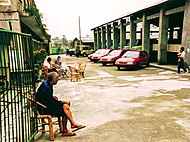
The
Citroën is a global brand, except in North America, where the company has not returned since the SM was effectively banned in 1974 for not meeting U.S. National Highway Traffic Safety Administration (NHTSA) bumper height regulations.
In 2016, Peugeot–Citroën South Africa (PCSA) announced that they were going to stop importing new Citroën models into South Africa [47] in order to focus on increasing Peugeot's sales in the country. In May 2019, it was reported that PCSA would re-introduce the Citroën brand into South Africa,[48] this was later confirmed by PCSA, in August 2019, that new Citroën models will go on sale in the middle of October 2019.[49]
Recent decades

From 2003 to 2010, Citroën produced the C3 Pluriel, an unusual convertible with allusions to the 1948–1990 2CV model, both in body style (such as the bonnet) and in its all-round practicality. In 2001 it celebrated its history of innovation when it opened a museum of its many significant vehicles: the Conservatoire with 300 cars.[50] In line with the severe decline in European car sales after 2009, worldwide sales of vehicles declined from 1,460,373 in 2010 to 1,435,688 in 2011, with 961,156 of these sold in Europe.[51]
In 2011, the PSA Group was close to forming a partnership with BMW, for the development of electric and hybrid vehicles, but the talks fell through, shortly after Groupe PSA, Citroën's parent company, had announced a partnership with GM, which later also failed.
The brand ranked highest in the 2014 customer satisfaction survey by JD Power in China, above luxury brands like Mercedes-Benz and BMW, and above mass market brands, like Volkswagen, ranking only thirteenth and seventeenth respectively.[46] In the first ten months of 2014 in China, the sales of Dongfeng Citroën cars increased by 30% in an overall market growth of 11%.[45] Despite the near-death financial experience of
In January 2020, Linda Jackson was succeeded as CEO of Citroën by the deputy CEO Vincent Cobée, and she would instead "lead a study to clarify and support brand differentiation within a brand portfolio".[54]
Citroën entered the Indian market in early 2021 with the launch of the C5 Aircross SUV manufactured at the Hindustan Motors Thiruvallur plant in Tamil Nadu, India.[55][56]
DS brand
In early 2009, Citroën announced the development of the premium brand DS, for Different Spirit or Distinctive Series (although the reference to the historical Citroën DS is evident), to run in parallel to its mainstream cars. The slogan of the DS car marque is "Spirit of avant-garde".[57]
This new series of cars started early in 2010, with the
The DS series is deeply connected to Citroën, as the
In China, Citroën has standalone DS showrooms, as well as entire plants built specifically for the production of these vehicles.
Awards
Citroën was recognised in the 1999 Car of the Century competition as producing the third most influential car of the 20th century, the Citroën DS, behind the Ford Model T and BMC Mini.
Citroën has produced three winners of the 50-year-old European Car of the Year award, and many rated second or third place.
- 1971 – Citroën GS
- 1975 – Citroën CX
- 1990 – Citroën XM
Citroën has produced one winner of the United States Motor Trend Car of the Year award – the original Car of the Year designation, which began in 1949. This was especially significant because this award used to be only given to cars designed and built in the United States.[69]
- 1972 – Citroën SM
Citroën has produced eight Auto Europa winners in 28 years, since 1987. Auto Europa is the prize awarded by the jury of the Italian Union of Automotive Journalists (UIGA), which annually celebrates the best car produced at least at 10,000 units in the 27 countries of the European Union:
In 2023, Citroën won the 'Sustainability Initiative Award' of the year at the Auto Trader New Cars Awards 2023.[70][71]
Motorsport
Citroën Racing, previously known as Citroën Sport and before that as Citroën Competitions, is the division responsible for Citroën's own sporting activities. It is a successful winning competitor in the World Rally Championship and in the World Touring Car Championship.[72]
Early rally wins for Citroën vehicles


Citroën vehicles were entered in endurance rally driving events beginning in 1956, with the introduction of the DS.[73] The brand was successful and won many key events over a decades long period, with what was essentially the same production car design.
|
Racing the 2CV
Citroën discovered that while racing the uniquely slow 2CV against other cars made little sense, they could be interesting to watch racing against each other. Citroën Competitions sponsored three long distance competitions – Paris-Kaboul-Paris in 1970, Paris-Persepolis-Paris in 1972, and Raid Afrique in 1973.[74][75]
Enthusiasts carried on the tradition with 2CV Cross – a group of 2CV's racing around a dirt track – a sport that continues today.[76][77]
Rebuilding the competition group
The Citroën Competitions division was impacted negatively by the firm's 1974 bankruptcy.[73]
Competitive rallying was also changing – away from standard production cars to specially developed low volume models. In response to the entry of the competitive short wheel base
The team returned successfully with the
From 2001, the Citroën Racing team returned successfully to the
The Citroën World Rally Team has a record of 97 victories in the World Rally Championship.
New competition division for touring cars
In 2012, Citroën announced plans to enter the World Touring Car Championship.[78] The team transformed a DS3 WRC into a laboratory vehicle to help with early development, while the engine was an evolution of their WRC engine which had been used in the WRC since 2011.[79] Citroën started developing the car for the new TC1 regulations, which were brought forward a year early in 2014 to expedite the entry of Citroën into the championship.[80] The introduction of the new regulations a year earlier than planned gave a seven-month development headstart to Citroën over the other manufacturers.[81] This large development advantage combined with a big budget and a strong driver line-up made Citroën the clear favourite going into the first season of the new regulations in 2014.[82][83] Citroën would go on to win most of the races that season as well as the manufacturers' title, while José María López won the drivers' title. The team would repeat this feat in 2015 and 2016, before the factory team left the series at the end of 2016. A number of Citroëns were still raced by other teams in 2017, but were outpaced by the Hondas and the Volvos.[84]
Concept cars
Citroën has produced numerous
Logo

The origin of the logo may be traced back to a trip made by the 22-year-old André Citroën to the city of
The presentation of the logo has evolved over time. Before the war, it was rendered in yellow on a blue background. After the war, the chevrons became more subtle herringbones,[87] usually on a white background. With the company searching for a new image during the 1980s, the logo became white on red to give an impression of dynamism.
On 5 February 2009, Citroën launched a new brand identity to celebrate its 90th anniversary, replacing the 1985 design. The new logo was a 3D metallic variation of the double chevron logo accompanied by a new font for the Citroën name and the new slogan "Créative Technologie". A TV campaign reminiscing over 90 years of Citroën was commissioned to announce the new identity to the public.[88] In 2022, the brand unveiled a new badge design which is a modern-day representation of its original 1919 logo, returning the oval shape to the two chevrons.[89]
Logo evolution
Citroen logos through the history:[90][91]
-
1919 - 1921
-
1921 - 1932
-
1932 - 1936
-
1936 - 1959
-
1959 - 1966
-
1966 - 1985
-
1985 - 2009
-
2005 - 2012 (badge)
-
2009 - 2016
-
2016 - 2022
-
2021 - 2022
-
2022–present
Factories
- Argentina (Barracas, Buenos Aires by Citroën Argentina 1959–79)
- Argentina (El Palomar, 1998–present): C4 Lounge (2013-2021), Berlingo
- Brazil (C3
- France (Mulhouse): DS 4 (2010-2018), DS 7
- France (Poissy): DS 3
- France (Rennes): C5 Aircross[92]
- France (Sochaux): DS 5 (2011-2018)
- India (Chennai, Tamil Nadu): C5 Aircross, C3
- Portugal (Mangualde): Berlingo
- Slovakia (Trnava): C3
- Spain (Madrid): C4 Cactus
- Spain (Opel Zaragoza): C3 Aircross
- Spain (Vigo): Berlingo First, Berlingo, Xsara Picasso, C4 Picasso / C4 Grand Picasso, C-Elysee
- Turkey (Tofaş Bursa): Nemo (2007-2017)
Some joint venture models are manufactured in third party or joint venture factories, including the following:
- China (DS 6WR
- China (Dongfeng Peugeot-Citroën Automobilejoint venture: C-Elysee, C3 L, Xsara Picasso, C4 L, C5
- Czech Republic (Kolín), Toyota/PSA joint venture: C1
- France (Sevel Nord: Citroën Jumpy/Dispatch
- India (C3
- Italy (Sevel Sud: Jumper/Relay
- Japan (Mizushima). Mitsubishi Motorsplant: C-Zero
- Russia (Kaluga), PSA/Mitsubishi joint venture : C4, C-Crosser
- Iran (Kashan): SAIPA Citroën JV :C3, C3xr, C4
- Turkey, Karsan plant: Berlingo
Current product lineup
Citroën
DS line
Dongfeng Peugeot-Citroën (joint venture)
-
Citroën C-Quatre (previously Citroën C-Triomphe)
-
Citroën C4 sedan, called C4L or C4 Lounge
See also
- List of automobile manufacturers of France
- List of companies of France
- Lane departure warning system
References
Footnotes
- Tréma) indicating the two vowels are sounded separately, and not as a diphthong.
Notes
- ^ "Legal notices". Automobiles Citroën. Retrieved 3 July 2023.
- ^ "2015 Registration Document". Groupe PSA. pp. 7, 8. Retrieved 12 November 2016.
- ^ "Saint-Ouen retrouve son fleuve, la Seine". l'Humanité (in French). 28 October 2006. Archived from the original on 30 September 2008.
La mort lente des petites entreprises, la délocalisation des plus importantes ont transformé Saint-Ouen. Il ne reste en centre-ville que l'usine Citroën
- ^ "The Company". citroen.com. Archived from the original on 11 May 2010. Retrieved 19 September 2007.
- ^ Peugeot Motion and Emotion, Corporate interactive history, Undated. Retrieved: 9 April 2012.
- ISBN 978-0756671679.
- ISBN 978-1844253203
- ^ "Driven: Citroën Berlingo Multispace". The Daily Telegraph. 26 July 2012. Archived from the original on 12 January 2022. Retrieved 23 June 2014.
- ^ "Citroën DS". vintagecars.about.com. Archived from the original on 4 January 2007. Retrieved 6 September 2007.
- ^ a b c d e f g h i j "Automobilia". Toutes les Voitures Françaises 1920 (Salon [Oct] 1919). 31. Paris: Histoire & collections: 65. 2004.
- ^ ISBN 978-0385042352)., p. 317.
- ^ ISBN 978-1586637620. Retrieved 10 June 2017.
- ^ "European Motor News". Archived from the original on 10 July 2011. Retrieved 29 May 2010.
- ^ Williams, Maynard Owen (October 1931). "The Citroën-Haardt Trans-Asiatic Expedition Reaches Kashmir". National Geographic. Vol. LX, no. 4. National Geographic Society.
- ^ "1923 5CV Citroën, National Museum of Australia". Nma.gov.au. Archived from the original on 3 December 2008. Retrieved 1 August 2011.
- ^ "Citroën Cars History | Our brand". Citroën UK.
- ^ "Citroën Heritage". Archived from the original on 23 August 2010.
- ISBN 9780292737846.
stomach .
- ^ "Automobilia". Toutes les Voitures Françaises 1938 (Salon [Oct] 1937). 6. Paris: Histoire & collections: 26. 1998.
- ISBN 9780521849746.
- ISBN 978-1-84425-207-7.
- ISBN 978-1-84425-207-7
- ^ "1963 Citroen DS-19 | Hagerty – Classic Car Price Guide". Archived from the original on 29 November 2014. Retrieved 18 November 2014.
- ^ a b Autotrader autotraderclassics.com [dead link]
- ^ "Citroën XM - Classic Car Review | Honest John". Classics.honestjohn.co.uk. Retrieved 16 July 2016.
- CAR MagazineAugust 1979 Long-Term Test CX Familiale
- ^ Werminghausen, Martin (11 February 2014). "Mercedes Air Suspension" (PDF). 600airsuspension.com. Retrieved 12 January 2022.
- ^ a b c d e f g h "Citroen's Partnerships". Citroen Car Club. Archived from the original on 29 November 2014.
- ^ "Citroën DS a subjective view". Citroenet.org.uk. 10 June 2000. Retrieved 16 July 2016.
- ^ ISBN 0-85045-381-X
- ^ "Citroën DS prototypes The birth of a Goddess 1". Citroenet.org.uk. 10 June 2000. Retrieved 16 July 2016.
- ^ "Citroën GS Birotor 107 hp - Specs & Performance". Zeperfs.com. 15 November 2014. Archived from the original on 20 March 2016. Retrieved 16 July 2016.
- ^ Glon, Ronan (22 October 2013). "A quick look at the Citroën GS Camargue". Ran When Parked. Retrieved 16 July 2016.
- ^ "Citroën SM V6 2.7 c 170 hp - Specs & Performance". Zeperfs.com. 6 April 2015. Archived from the original on 6 August 2016. Retrieved 16 July 2016.
- ^ "Automobilia". Toutes les Voitures Françaises 1972 (Salon [Oct] 1971). 76s. Paris: Histoire & collections: 19. 2005.
- ^ a b "Automobilia". Toutes les Voitures Françaises 1975 (Salon Paris Oct 1974). 72. Paris: Histoire & collections: 19. 2005.
- ^ a b Marsh, Julian. "A Brief History of Citroën Page 3". Citroenet.org.uk. Retrieved 16 July 2016.
- ^ "The Glasgow Herald - Google News Archive Search". news.google.com.
- ^ Peugeot Motion and Emotion, Corporate interactive history, Undated Archived 6 June 2011 at the Wayback Machine. Retrieved: 9 April 2012.
- ^ a b c d "Automobilia". Toutes les Voitures Françaises 1982 (Salon [Oct] 1981) "J'accuse la CGT de Vouloir Nous Asphyxier Pour Mieux Nous Nationaliser: C'est Une Technique Aussi Sure Que le Supplice du Garrot; Ni les Tribunaux, Ni les Ministres N'y Peuvent Rien Changer". 80s. Paris: Histoire & collections: 9. 2006.
- ^ "PRN satellites - lunule". www.citroenet.org.uk.
- ^ "Citroën Xantia (1993 - 2000)". Honest John. 24 July 2016. Retrieved 12 June 2017.
- ^ "Tamerlane's Thoughts: Citroën CX Taxi Cabs". Karakullake.blogspot.com. 18 April 2009. Retrieved 16 July 2016.
- ^ a b c d De Feijter, Tycho (12 July 2016). "Hands Off! These 8 Citroëns Are Only For China". Forbes. Retrieved 12 July 2016.
- ^ a b "DPCA sold 518,000 vehicles in China, an increase of 30% in a market up 11%". Automotive News. 18 July 2014. Retrieved 10 November 2014.
- ^ a b "Dongfeng Citroën tie for top score in China satisfaction survey". JD Power. 18 July 2014. Retrieved 10 November 2014.
- ^ Downard, Miles (8 December 2016). "Citroën to pull out of South Africa". BizNews.com. Retrieved 7 September 2019.
- ^ "Citroën is coming back to South Africa". TimesLIVE. Retrieved 7 September 2019.
- ^ "Citroën will start selling new cars in South Africa again". businesstech.co.za. Retrieved 7 September 2019.
- ^ "Citroën's Museum - Le Conservatoire". Citroën Car Club. Archived from the original on 29 November 2014.
- ^ "Annual Report Presentation 2011". PSA Peugeot Citroën. Retrieved 27 June 2012.
- ^ Hotten, Russell (19 February 2014). "Peugeot signs rescue deal with China's Dongfeng Motor - BBC News". Bbc.com. Retrieved 16 July 2016.
- ^ Cropley, Steve (24 November 2015). "Revolutionary Citroën suspension system to launch in 2017". Autocar UK. Retrieved 12 July 2016.
- ^ Attwood, James (15 January 2020). "Citroën and DS get new bosses in PSA reshuffle". Autocar. Retrieved 5 June 2020.
- ^ "India-spec Citroen C5 Aircross SUV Unveil On February 1 - ZigWheels". ZigWheels.com. Retrieved 9 January 2021.
- ^ "Citroën C5 Aircross SUV's India unveil date out: What to expect from Karoq, Compass rival". The Financial Express. 4 January 2021. Retrieved 9 January 2021.
- ^ "2015 Geneva Motor Show: DS enters a new era of the spirit of avant-garde". Automotive News. 3 March 2015. Retrieved 12 March 2015.
- ^ "Citroën DS3 first supermini in the 2012 JD Power Satisfaction Survey". JD Power. 24 May 2012. Archived from the original on 1 July 2018. Retrieved 28 October 2014.
- ^ "Citroën DS3 first supermini in the 2013 JD Power Satisfaction Survey". New Zealand Herald. 3 June 2013. Retrieved 28 October 2014.
- ^ "Citroën DS3 first supermini in the 2014 JD Power Satisfaction Survey". JD Power. 28 May 2014. Retrieved 28 October 2014.
- ^ "Citroën C3 and DS3, most efficient small cars". What car ?. 28 May 2014. Retrieved 28 October 2014.
- ^ "First Citroën DS4 launched". Auto-Power-Girl.com. Archived from the original on 25 September 2020. Retrieved 7 December 2014.
- ^ "First Citroën DS5 launched". Auto-Power-Girl.com. Archived from the original on 26 September 2020. Retrieved 8 October 2014.
- ^ "Citroën DS returns | Auto Express News | News". Auto Express. 6 February 2009. Retrieved 17 September 2009.
- ^ "Site officiel de la CITROËN DS3". Ds3.citroen.com. Retrieved 17 September 2009.
- ^ "First Citroën Survolt Concept". Auto-Power-Girl.com. Archived from the original on 25 September 2020. Retrieved 8 October 2014.
- ^ Smy, Damion (15 April 2014). "Citroen DS 6WR (2014) first official pictures". Car. Retrieved 16 June 2014.
- ^ "Citroën goes sporty with the DS 5LS R for the 2014 Beijing Auto Show | CarNewsChina.com - China Auto News". CarNewsChina.com. 7 April 2014. Retrieved 16 July 2016.
- ^ Nagy, Chris (14 November 2012). "Powered Up: Tesla Model S Named 'Car of the Year' By Motor Trend". Automoblog.net. Retrieved 16 July 2016.
- ^ "The Sustainability Initiative Award 2023 – Citroën". AutoTrader. Retrieved 21 September 2023.
- ^ "CITROËN SCOOPS SUSTAINABILITY INITIATIVE OF THE YEAR PRIZE AT AUTO TRADER NEW CAR AWARDS 2023". Stellantis. Retrieved 21 September 2023.
- ^ "WTCC targets major cost reduction programme for 2017". us.motorsport.com. 27 April 2016. Retrieved 9 April 2019.
- ^ a b "Citroën DS in sport". Citroenet.org.uk. 10 June 2000. Retrieved 16 July 2016.
- ^ "Paris-Persepolis-Paris - www.passion-citroen.com". 6 October 2013. Archived from the original on 6 October 2013.
- ^ http://raid2cv-cinoche.blogspot.com in French
- ^ "History of the club". Archived from the original on 19 June 2013. Retrieved 2 December 2014.
- ^ "in French". 2cvcross.fr. Archived from the original on 28 December 2017. Retrieved 16 July 2016.
- ^ "Citroën Committed To WRC, Considering WTCC Entry With Sebastien Loeb". Motor Authority. 28 September 2012. Retrieved 13 April 2020.
- ^ "Citroën continues intense testing programme". TouringCarTimes. 24 January 2014. Retrieved 13 April 2020.
- ^ "How the 2014 WTCC is shaping up so far". TouringCarTimes. 14 October 2013. Retrieved 13 April 2020.
- ^ "WTCC boss expects closer fight between the manufacturers this year". TouringCarTimes. 17 February 2015. Retrieved 13 April 2020.
- ^ "Citroën Racing ready for WTCC debut at Marrakech". TouringCarTimes. 4 April 2014. Retrieved 13 April 2020.
- ^ Cozens, Jack (26 December 2015). "Rob Huff certain Citroën quitting is good for the WTCC". Autosport.com. Retrieved 13 April 2020.
- ^ "TouringCarTimes' Top 30 drivers of 2017: 10 to 1". TouringCarTimes. 28 December 2017. Retrieved 13 April 2020.
- ^ "Citroën Logo: Design and History". FamousLogos.net. Archived from the original on 18 October 2012. Retrieved 19 August 2011.
- ^ "Autocar Handbook". The Autocar (Ninth ed.). London: Iliffe & Sons. c. 1919.
- ^ "Logo: Citroën". Archived from the original on 16 February 2013. Retrieved 18 March 2014.
- ^ "90 Years Citroën TV Ad (Youtube Video)". YouTube. Archived from the original on 2 November 2021.
- ^ "Citroen Unveils New Logo Inspired from Its Past, Teases New Concept". 27 September 2022.
- ^ Smith, Fred (30 September 2022). "Citroën Is Getting a New Logo". Car and Driver.
- ^ Finney, Alice (30 September 2022). "Citroën returns to original logo to create "symbol of progress" for electric era". dezeen.
- ^ AMS (25 June 2018). "PSA adds fourth shift to Rennes plant". Automotive Manufacturing Solutions. Retrieved 14 August 2020.
Bibliography
- Broustail, Joël; Greggio, Rodolphe (2000). Citroën: Essai sur 80 ans d'antistratégie [Citroën: Essay on 80 years of doing its own thing] (in French). Paris: Vuibert. ISBN 2711778185.
- Gallard, Philippe (2004). A l'assaut du monde: L'aventure Peugeot-Citroën [Storming the World: The Peugeot-Citroën Adventure] (in French). Paris: Bourin. ISBN 2849410136.
External links
- Official website

- Citroën Origins (historical models)

